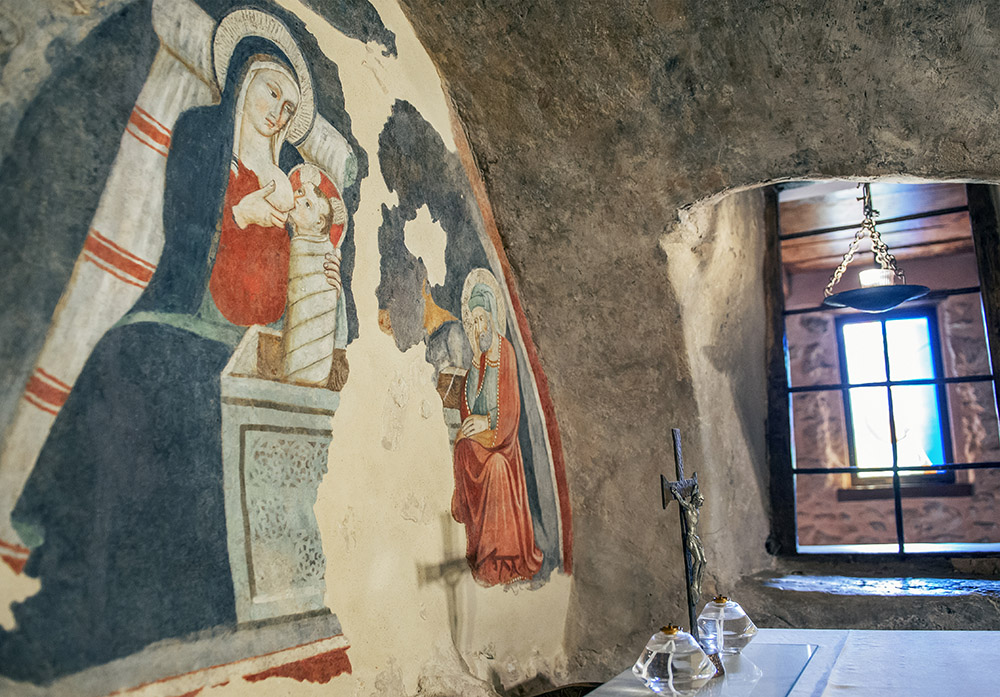St. Francis, Kurt Vonnegut and the Radical Absurdity of the Incarnation

My 19-month-old pointed toward his shelf of Christmas books, "Boke?" He wanted to pick another book for me to read to him before bed, which I assumed would be about another snowman, his new obsession. I sometimes try to talk him out of the snowman books, as if I'm the one who is supposed to be entertained.
But this time he pointed to my favorite children's book, Sun Moon Star, written by one of my favorite authors, the late, great satirist Kurt Vonnegut.
Whereas most illustrators design their work after the author has written their story, this book had the opposite creative process. Renowned graphic designer Ivan Chermayeff first made the illustrations, then had Vonnegut write a story to fit the artwork, as if the author of Slaughterhouse-Five (or, my personal favorite, Breakfast of Champions) needed an outlet to be any weirder.
In Sun Moon Star, Kurt Vonnegut tells the Christmas story through the undeveloped eyes of the newborn baby Jesus, using illustrations by Ivan Chermayeff. (Courtesy of Seven Stories Press)
Sun Moon Star, Vonnegut's only children's book (which is probably a good thing for the sake of all malleable minds), is a Christmas book because of the story he chose to tell.
Flip through the illustrations, and it feels as if Chermayeff was trying to purposefully prevent Vonnegut from being able to put anything coherent together. It begins with an intricate sketch detailing the anatomy of an eyeball, then features more than 20 pages of simple, jagged shapes — suns, moons, stars — as well as pages that are completely one color. The shapes vary in size throughout the book, sometimes multiply and other times intersect with one another.
I think my son made it to the eyeball drawing before he started screaming for the snowman.
In Sun Moon Star, Vonnegut brilliantly tells the Christmas story through the undeveloped eyes of the newborn baby Jesus, this "Creator of the Universe" who "had never had needs for eyes before" since "it had known all things and been all things."
For a blank green page, Vonnegut wrote, "Its fourth dream was simply green. It had never seen green before."
He described a rounded sun as Mary's shoulder and a star perched atop a crescent moon as Joseph in the doorway with a lantern.
For a page that featured the three shapes twisted together, Vonnegut wrote, "The Creator now saw a sun, a moon and a star come together in an impossible cosmic tangle. What could be the explanation? The baby's eyes had crossed."
Some may think the book borders on sacrilege, though the book opens with those celebrated words from Isaiah 7:14 about Emmanuel meaning "God with us." Written by a freethinking humanist who once described himself as a "Christ-loving atheist," Vonnegut was unafraid to critique religion in his work.
I, however, not only think the book is hilarious but also find it theologically beautiful. Vonnegut, a literary expert in his depiction of the absurdity of the human condition, now elevates the radical absurdity of Christ's human condition through the Incarnation: the Creator of the Universe reduced to a helpless infant, unable to decipher his surroundings, seeing colors and vague shapes and, yes, probably crossing his eyes.
Was this not a semblance of what St. Francis of Assisi was also doing when he set up a live Nativity 800 years ago in the little town of Greccio? (I doubt anyone has ever bridged Vonnegut to Francis before, but there is a first time for everything.)
At a time when Jesus was often depicted as a conquering, victorious king on a throne, a God-view used to justify crusades and other conversion-focused missions, Francis helped people refocus on the humanity and humility of Christ. In the mystery of the Incarnation, Francis saw the heart of God.
I was recently given the opportunity to visit Italy on a Franciscan pilgrimage. At Greccio, our guides helped my imagination expand as they explained the shocking qualities of Francis' live Nativity. Francis sought to make the Nativity reenactment as human and real as possible: in the middle of the night, in the freezing cold, with not only real people but also real animals who likely smelled and perhaps even used the bathroom there in that tiny cave.

The grotto at the Sanctuary of Greccio, Italy, where St. Francis of Assisi set up a live Nativity scene in 1223 (Wikimedia Commons/MonDoMD)
The people of Greccio, who adored Francis and his brothers, would have found this immersive experience to be unique, maybe beautiful, but it was far from comfortable or pleasant. Maybe this was Francis' point. Sometimes in our romanticization of the Christmas story, we forget its absurdity.
Francis, of course, was no stranger to the realm of the absurd. This was a man who denounced his father by stripping naked before the bishop; who would voyage barefoot to far-off places like Rome and Greccio and La Verna; who once journeyed "behind enemy lines" in the middle of the Fifth Crusade with hopes of meeting the sultan, commander of the Muslim army (they did meet, spent several days together and became friends).
Legend has it that one Christmas Eve, as banquets took place around Assisi and his brothers became conscious of their own hunger and poverty, Francis took a large piece of meat from the table where his brothers sat and rubbed it against the wall saying, "Even the walls must eat meat in celebration!"
These are the actions of a saint with a flare for the theatrical — actions that today could be interpreted as those of a brilliant madman, perhaps another overlapping trait with Vonnegut. Sometimes it takes absurd people to communicate absurd truths.
On the back wall of the grotto in Greccio is now a fresco from the early 15th century, attributed to an artist called Narni. The right side of the fresco might be shocking to our modern eyes, as Mary holds her bare breast and presses it into the mouth of the suckling Godchild. It can feel disrupting, almost provocative, as if we want to shield our eyes from this nakedly human moment between the Virgin and the Savior.
But maybe this was the artist's point, forcing the viewer to confront the radical absurdity of the Incarnation: the God of the universe entirely dependent upon Mary's breast milk to live.
Any Christian spirituality that does not cultivate human dignity is not anchored in the Incarnation. God not only comes to our world through a human being, but becomes a vulnerable infant dependent upon other humans for survival. Narni's fresco succeeds in communicating the messy physicality of the Incarnation, mirroring the themes Francis elevated that cold night in 1223.
Here on the 800-year anniversary of Francis' live Nativity at Greccio, we're invited to reflect upon the Christmas story in a different way, in an absurd way, which is to say contemplating the revolutionary mystery of God being big enough to become that small.
Yes, there was a magic, a mystical thinness, to the Christmas story, but Jesus would have known none of it. In that stable Jesus would have breastfed and peed and pooped and slept and probably screamed and cried from the discomforts of his straw bed.
To the infant, the shepherds, wise men, animals and that divinely chosen couple would have been convoluted shapes and colors. Or as Vonnegut concludes on the opening page of Sun Moon Star, "The Creator had only to exist. That was enough. But now, as a human infant, It was also going to see — and to do so imperfectly, through two human eyes, each a rubbery little camera."
To dare see through God's eyes means something entirely different at Christmas.
